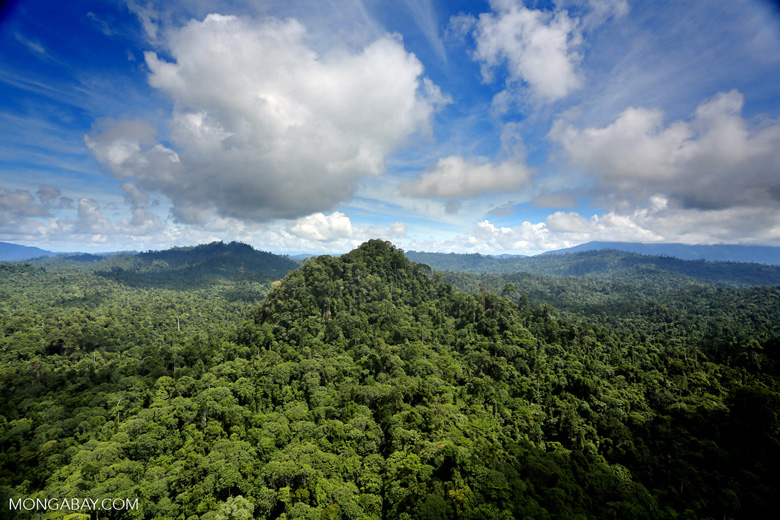- After 2015’s radical advancements in transparency around tropical forests between improved forest cover monitoring systems and corporate policies on commodity sourcing, progress slowed in 2016 with no major updates on tropical forest cover, resistance from several governments in releasing forest data, and some notable backtracking on zero deforestation commitments.
- But even without the pan-tropical updates, we know that deforestation increased sharply in the Brazilian Amazon, which accounts for the world’s largest area of tropical forest.
- Low commodity prices may have bought some relief for forests.
Massive forest fires in the Congo and Amazon, surging deforestation in Brazil, and tentative steps toward reform in Indonesia and Myanmar: there were no shortage of major happenings in tropical forests around the world in 2016. Here’s a laundry list of some of the biggest rainforest stories from the past year.
Please note that this post does not cover developments in sub-tropical, temperate, or boreal forests. Additionally, this list is by no means exhaustive, so feel free to highlight stories we missed via the comment section at the bottom of the post.
Reviews from past years: 2015 | 2014 | 2013 | 2012 | 2011 | 2009
The big picture | Latin America | Africa | Asia | Commodities | Rights and governance | Conservation and ecology
THE BIG PICTURE
After 2015’s radical advancements in transparency around tropical forests between improved forest cover monitoring systems and corporate policies on commodity sourcing, progress slowed in 2016 with no major updates on tropical forest cover, resistance from several governments in releasing forest data, and some notable backtracking on zero deforestation commitments.
But even without the pan-tropical updates, we know that deforestation increased sharply in the Brazilian Amazon, which accounts for world’s largest area of tropical forest. Whether that trend was mirrored in other countries is presently unclear, but low commodity prices may have bought some relief for forests. The global commodity price index in 2016 was the lowest since 2004 and several commodities often produced at the expense of rainforests — beef, timber, palm oil, rubber, and soybeans — remained well below recent highs.
LATIN AMERICA
A study published in Environmental Research Letters confirmed that clearing for cattle pasture is overwhelmingly the largest driver of deforestation in Latin America, accounting for over 70 percent of forest loss in the region from 1990 to 2005. Commercial agriculture ranked second at 14 percent.
Brazil
With the country mired in a deep political and economic crisis, it was easy to forget about Brazil’s forests, but there was plenty happening, including a big surge in deforestation that brought Brazil’s forest loss in the Amazon to 7,989 square kilometers for the year ending July 31, 2016, the highest level since 2008. The data, which is still preliminary, suggests that the annual rate of primary forest loss in the Brazilian Amazon has climbed 75 percent over its 2012 level, which was the lowest since annual record keeping began in 1988. While the increase was predicted well ahead of time by both the government and Brazilian NGO Imazon, it raised fears about a recent push to roll back environmental regulations. For example, in December Congress attempted to strip environmental laws just before its annual recess.
Brazil’s ambitious dam-building spree in the Amazon suffered some setbacks in 2016. In April, the São Luiz do Tapajós dam license was suspended by IBAMA, the country’s environmental regulator. The dam, which would have flooded 400 square kilometers and resulted in the loss of 2,200 square kilometers of forest, would have been the largest in the Tapajós watershed, where up to 40 dams are planned. IBAMA’s decision was re-confirmed in August. In September, a Brazilian judge suspended the operating license for Belo Monte, Brazil’s largest dam and the third biggest in the world. Just a few weeks later Luiz Alberto Araújo, head of the Altamira municipal government environmental department, was gunned down. Araújo had led an investigation into fish kills at Belo Monte and played a key role in the arrest of an illegal logging kingpin.
A number of reports and studies looked at the impact of Brazil’s rainforest dams, including land speculation ahead of dam construction, risks to biodiversity, flooding, and deforestation.
The Brazilian soy industry extended its moratorium on deforestation indefinitely. The agreement, first signed in 2006 after a Greenpeace campaign, had previously been renewed on an annual basis, regularly raising fears among environmentalists that it might not be renewed despite its success in helping curb deforestation for soy production in the Brazilian Amazon.
Pão de Açúcar, one of Brazil’s largest supermarket chains, pledged to stop stocking beef linked to Amazon deforestation or produced by enslaved workers.
On the conservation front, Brazil recognized the traditional land rights for the Arara people. The new indigenous reserve, called Cachoeira Seca, covers 734,000-hectares. Brazil also announced a 22 million hectare restoration commitment, including rehabilitation of 12 million hectares of deforested land and 10 million hectares of agricultural land. And finally, the state of São Paulo turned over 25 state parks management concessions to the private sector.

Bolivia
Bolivia was hit by its strongest drought in 25 years. The drought affected about 40 percent of the country.
A two-year expedition of Madidi National Park led by the Wildlife Conservation Society turned up its thousandth bird species.
Areas in the Bolivian Amazon are being overrun by informal gold miners who are causing water pollution and deforestation.
Indigenous communities raised concerns about the construction of dams on the Beni River. The dams will flood tracts of forests and indigenous lands.
A sugar company scaled up forest conversion for cane fields near Madidi National Park. The company intends to clear nearly 12,000 hectares of forest by 2023.
Colombia
Colombians rejoiced over a peace agreement reach with The Revolutionary Armed Forces of Colombia (FARC) after 50 years of conflict, but some raised concerns that peace could bring industrial development to forests that were off limits to drilling, extraction, and conversion due to FARC’s presence. The government however had made commitments to protect vast swathes of the Colombian Amazon and turned large areas of the country over to indigenous management.
Coca’s impact on driving deforestation in Colombia appears to be overstated, concluded a study published in BioScience.
Ecuador
Ecuador moved ahead with oil drilling in its famed Yasuni National Park.
The were signs of rapid smallholder expansion of oil palm plantations near large, established plantations. Ecuador is the fifth largest palm oil producer in Latin America.
A report from Amazon Watch, a California-based advocacy group, reported than while U.S. crude imports are declining overall, imports from Ecuador are rising.
President Rafael Correa continued a crackdown on journalists, environmental campaigners, and indigenous community leaders who raised questions about development projects, including oil extraction, mining, and dams.
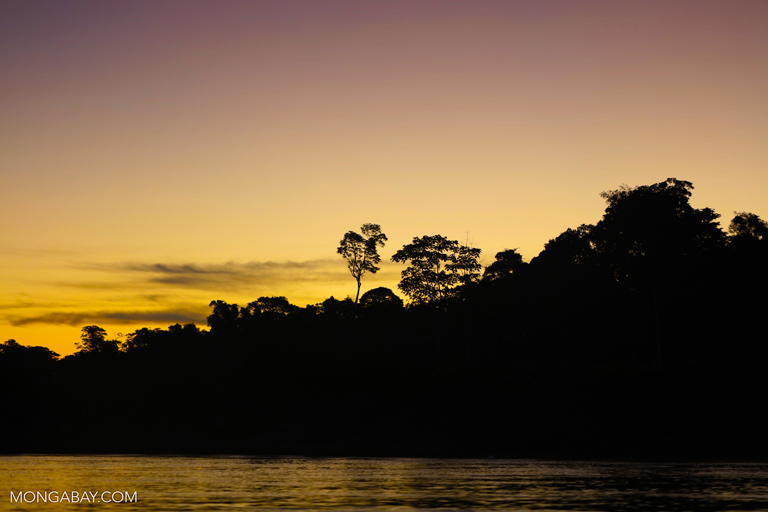
Peru
2016 got off to an inauspicious start for Peru‘s forests when the head of the country’s forest watchdog agency OSINFOR was unexpectedly terminated in January. OSINFOR had won wide praise from civil society for independently investigating corruption and mismanagement in Peru’s forestry sector. But its success had won it powerful enemies among Peru’s timber mafias.
Also in January, the government announced a new military base in Madre de Dios to combat illegal gold mining.
The Peruvian Amazon was plagued with a series of oil spills that caused widespread alarm in affected communities. Indigenous protesters staged a multi-month blockade aimed at Petroperú and the Peruvian government.
Illegal gold mining continued to chew into protected areas and high biodiversity areas. Pockets of illegal gold mining appeared in Northern Peru.
Pedro Pablo Kuczynski was elected in June as Peru’s new president, defeating Keiko Fujimori who had campaigned to legalize the informal gold mining sector.
A U.S. government report said 90 percent of Peru’s timber exports are illegal.
The Melka agribusiness empire had a series of setbacks with its cacao and oil palm plantations. The Peruvian government said that United Cacao’s plantings were improper, while the RSPO warned the Melka Group that its plantations were in breach of its sustainability policy. In June, the group took out ads in the Jakarta Post aiming to sell troubled oil palm concessions and it October it formally withdrew from the RSPO hindering its eventual ability to sell palm oil to premium buyers. Satellite data suggested that United Cacao continued to clear rainforest despite injunctions against it. The company’s stock, listed in London, plunged 61 percent for the year.
Fires made worse by severe drought conditions spurred the government to declare a state of emergency in November. Fires in Junin Department were said to be the worst in a decade. Local officials blamed climate change, although forest degradation from logging and deforestation as well as the effects of ENSO were likely bigger factors in exacerbating the fires.
Manu National Park was declared world’s top biodiversity hotspot by a group of researchers.
Suriname and Guyana
According to a report from Caribbean News Now, Suriname may finalize a 2004 agreement that would open 52,000 hectares of land for oil palm development. A Chinese company and an Indian company are said to be developing projects.
The Inter-American Commission of Human Rights ruled that the Surinamese government is violating the rights of indigenous peoples in failing to recognize, demarcate, and title indigenous territories.
The government of Guyana said it would repossess concessions granted to a Chinese logging company after an audit found misconduct. Baishanlin International Forest Development Inc. controlled 627,072 hectares of concessions, making it one of the largest logging companies in the country.
Venezuela
Cash-strapped Venezuela moved forward with the Orinoco Mining Arc, a controversial plan to open up to 12 percent of its land mass to foreign mining companies. The areas most coveted for coltan, gold, copper and diamonds often overlay the country’s most biodiverse ecosystems.
Small-scale gold mining continued to be a source of controversy.
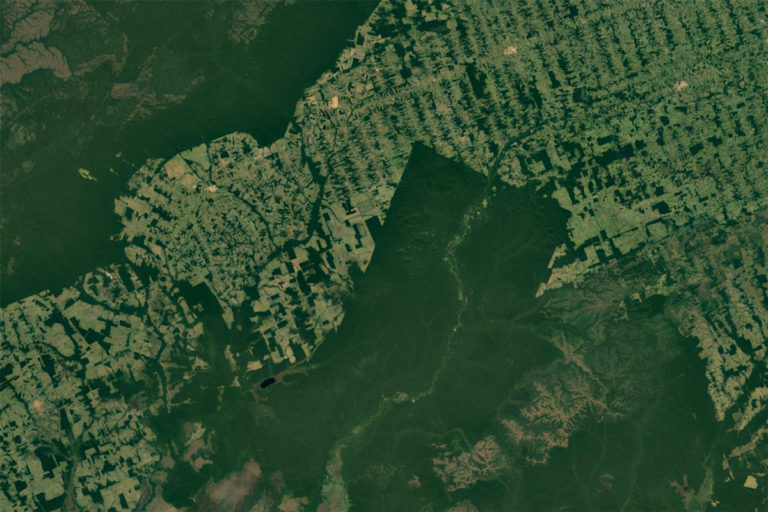
AFRICA
Congo Basin
The rainforest of Congo Basin countries — The Democratic Republic of Congo (DRC), Republic of Congo, Cameroon, Gabon, Central African Republic, and Equatorial Guinea — had a mixed 2016.
Things were relatively quiet in The Democratic Republic of Congo (DRC), which accounts for the bulk of Congo Basin forests. In early 2016, DRC announced it was considering lifting a 2002 moratorium on new industrial logging licenses, a proposal that was swiftly denounced by environmental groups. But continued political uncertainty in the country otherwise hindered investment and slowed large-scale rainforest conversion and exploitation. Small-scale clearing continued however, with one study arguing that market-driven production of cash crops are a bigger driver of deforestation than subsistence agriculture. On the conservation front, DRC declared its first new national park in 40 years, the 2.2 million-acre Lomami National Park. A U.S. NGO, the Rainforest Trust, provided financial support to the effort.
Republic of Congo meanwhile moved forward on with plans to potentially increase logging and mining in its forests. In early 2016, a massive fire swept through selectively logged forests in northern Congo at the same time that Brazzaville awarded two million hectares in new logging concessions, much to the chagrin of activist groups concerned about corruption and past abuses in the sector. Logging was also found to be underway in a block of forest set aside for the the Atama project, a 170,000-hectare oil palm plantation backed by a Malaysian company. The plantation itself seemed to be stalled, with only 700 hectares planted, raising questions about the true intentions of the project. Congo’s Ministry of Mines and Energy issued at least seven permits that allow companies to prospect or begin mining for gold inside Odzala-Kokoua, Congo’s largest national park, despite a ban on mining in protected areas.
Deforestation in the concession once controlled by Herakles resumed in Cameroon. Leaked cables revealed the U.S. government in 2013 encouraged Cameroonian officials to advance the controversial project despite environmental concerns and local opposition.
The government of Gabon finally formally adopted a framework that aims to increase revenue sharing between loggers and local communities. Olam, an agribusiness company based in Singapore, continued to clear thousands of hectares of rainforest for oil palm. The company touted its activities as being environmentally responsible, a claim disputed by Brainforest, a local NGO.
An initiative to map logging roads in the Congo Basin made traction in 2016. The data is available on Global Forest Watch, allowing researchers to correlate road development with forest disturbance and deforestation.
A Center for International Forestry Research (CIFOR) study estimated the Congo Basin’s pygmy population at 920,000. It warned that these traditionally nomadic cultures are facing grave threats from deforestation and external pressures.

Major developments in other African nations
In Nigeria a plan to build a superhighway through the buffer zone of Cross River National Park, including the Ekuri community-managed forest, spurred global outrage. More than 250,000 people signed a petition urging the government to revise the project.
A sapphire boom in Madagascar spurred a large-scale invasion of a rainforest reserve by 45,000 miners.
Confusion over land rights persisted in Liberia, with conflicts between companies, communities, and the government hampering efforts to increase benefit-sharing from logging as well as convert forest for industrial plantations. A proposed sale of timber from an oil palm concession — though rejected by the government — raised fears that agricultural companies could use “conversion timber” to skirt zero deforestation commitments.

ASIA
Cambodia
Cambodia granted protected status to five forest areas covering 1.8 million hectares, including Southern Cardamom National Park and the hotly contested Prey Lang forest, where journalists and activists had been killed advocating for its protection.
A report based on undercover investigations by Global Witness alleged that top Cambodia’s political leaders appropriated land and natural resources for their own benefit, amassing holdings in mining, logging, agriculture, and plantation companies. The report criticized Cambodia for harsh treatment of dissenters, including environmental campaigners, and ongoing violence against journalists and activists.
A tug-of-war over resources continued between the Ministry of Agriculture, Forestry and Fisheries and the Ministry of Environment.
Questions were raised about the efficacy of efforts to protect Botum Sakor National Park.
Indonesia
After last year’s catastrophic haze crisis which affected tens of millions of people across Southeast Asia, Indonesia started the year on a path to reform business-as-usual approaches to forest management. In January, Indonesian President Joko Widodo appointed conservationist Nazir Foead to head up a newly-created peatland restoration agency (BRG), charged with both restoring peatlands damaged by 2015’s fires and addressing the underlying causes of the country’s peat and forest fires. In what seemed to be an indication of the central government’s desire to pursue legal action against alleged perpetrators of the haze crisis, the head of the newly-merged Ministry of Environment and Forestry Siti Nurbaya indicated she would personally fight to overturn a lower court decision not to prosecute a pulp and paper company for fires that burned within its concession during the height of 2015’s disaster. Indonesians also took up their own efforts to hold companies and governments to account, with citizens filing suit against the Aceh government to stop a planned revision to the province’s spatial plan that could open forest areas to mining, logging, and plantations (later blocked in court). The private sector also took steps to reduce fire risk, with Asia Pulp & Paper (APP) developing a peatlands restoration model and conducting a massive peat mapping exercise. APP was especially vulnerable among Indonesia’s forestry giants because vast areas of its supplier concessions burned in 2015, destroying hundreds of thousands of hectares of timber plantations at a time when the company is building a massive new pulp mill. In South Sumatra alone, 293,065 hectares of land went up in smoke.
In February, Astra Agro Lestari, one of Indonesia’s most powerful palm oil companies, became the sixth firm to join the Indonesian Palm Oil Pledge (IPOP), a private sector initiative that aimed to improve the environmental performance of the palm oil sector, including lobbying the government to adopt and support policies that enable companies to better protect forests. The move however was not welcomed by everyone — several politicians and ministry officials called for the disbandment of IPOP, likening it to a “cartel” that placed limits on Indonesia’s palm oil expansion and therefore threatening national sovereignty. The opposition would eventually doom the initiative: in late June IPOP was disbanded. The companies — Wilmar International, Cargill, Golden Agri-Resources, Asian Agri, Musim Mas and Astra Agro Lestari — said they feared being investigated by Indonesia’s anti-monopoly agency. Some environmentalists called disbandment a major setback to sustainability efforts.
In February and March there were other positive developments for Indonesia’s forests. The antigraft agency KPK stepped up its Korsup Minerba initiative which launched provincial level probes into the mining sector, resulting in hundreds of permit cancellations. The Packard Foundation, a U.S. philanthropy, teamed with the Indonesian government to establish a one million dollar prize for devising the best way to map Indonesia’s peatlands.
Leonardo DiCaprio brought international attention to the plight of Sumatra’s forests and wildlife when he made a surprise visit to North Sumatra and Aceh. Indonesian officials scrambled to deport the Hollywood actor for highlighting the destructive practices of the palm oil industry only to learn that he left the country days earlier. A petition endorsed by DiCaprio attracted tens of thousands of signatures despite being about a relatively obscure topic: Aceh’s spatial plan revision.
The re-emergence of fires in Sumatra reiterated the importance of protecting and restoring peatlands and forests. Companies were called on to help.
In April, president Jokowi announced a freeze on new oil palm and mining permits. A month later the Ministry of Environment and Forestry followed through on moratorium, though it wasn’t yet legally binding. An official said the new moratorium would last five years, but it appears the prohibition will only last until the government finishes mapping and zoning the nation’s peatlands. The Ministry of Environment and Forestry also announced it would rezone 3.8m hectares of peatlands that had been protected under a 2011 moratorium but had been damaged or converted. Areas cleared for small-scale plantations and agriculture would be rezoned for smallholder use, while areas converted by large companies could be investigated and potentially sanctioned. The head of the peat restoration agency called for the protection of all peat domes.
Fires spread during the traditional dry season from July to October, but were nowhere near the levels seen in 2015. In August, Indonesian police arrested hundreds of individuals allegedly linked to fires in Sumatra and Kalimantan. Officials in the Ministry of Environment and Forestry also stepped up their criticism of companies linked to last year’s haze.
There were a number of high-profile alleged environmental transgressions by plantation companies, including Korindo in Indonesian New Guinea and PT RAPP digging drainage canals on an island off Riau. A study published in Applied Geography documented 187 land conflicts related to oil palm expansion in Kalimantan. A report by Chain Reaction Research found that while some of Indonesia’s palm oil giants have adopted sustainability policies under pressure from their buyers, there remain holdouts in the sector.
A study by Deltares found the Kampar Peninsula in Riau is being drained into oblivious by plantation companies. Sections of the peninsula are now so degraded that they are sinking below flood levels, risking inundation with sea water.
Indonesia and the E.U. finalized a timber licensing agreement that aims to curb illegal shipments.
Indonesian authorities canceled a license to log forests on the Mentawai islands after fierce opposition from local peoples. The action came just two years after another company tried to clear Mentawai forests for oil palm. That too was stopped by local protesters.
Indonesia declared a new national park in Riau, a province that lost most of its peatlands and forests to industrial oil palm and pulp and paper development in recent decades. Zamrud National Park, which spans 31,480 hectares and is home to two major lakes, offers habitat for the endangered Sumatran tiger.
Indonesia’s human rights commission published the results of its national inquiry into land conflicts affecting indigenous people. The report called for the government to recognize indigenous peoples’ rights giving new life to efforts to resurrect a long-stalled bill on the issue.
Environmentalists raised concerned about new energy projects, including Indonesia’s drive to establish more coal-fired power plants, a $17 billion dam on the Kayan River in Kalimantan, and a geothermal project in Aceh’s Leuser National Park (which may or may not be moving forward). Ahead of the UN climate summit in Morocco, the Indonesian government shifted its emissions reduction strategy from cutting emissions from the energy sector to cutting emissions from the forest sector.
In November citizen activists were handed a setback in their battle against Aceh’s spatial plan revision when the Central Jakarta District Court ruled against their class-action lawsuit. The plaintiffs said they would appeal but the Ach provincial government indicated it would proceed as it wishes, regardless of the verdict.
A critically endangered Sumatran rhino died after it was wounded by a poacher’s snare. The incident was significant because the rhino population’s whereabouts were revealed in 2013, spurring backlash from some conservationists who said the revelation would increase poaching in the area.
Concerns over lack of transparency in Indonesia’s forestry, agriculture, and mining sectors persisted throughout 2016, although observers said President Jokowi’s administration has been more transparent than prior administrations. The Ministry of Environment and Forestry was particularly intransigent, issuing conflicting or confusing information to different parties, blocking journalists’ requests for information, and seemingly delegating some official communications to a third party, non-government web site. In December the ministry took Greenpeace Indonesia to court over a request to publicly release geospatial maps in shapefile format. The ministry, which provided shapefiles of such data upon request until 2013, claims that the format is insecure and could be manipulated. NGOs complain that PDF and JPG files released by the ministry are next to useless when it comes to actionable analysis. Indonesia’s judiciary did set an important precedent when the highest court ordered the release of mining data under a freedom of information request filed by NGOs in 2014.
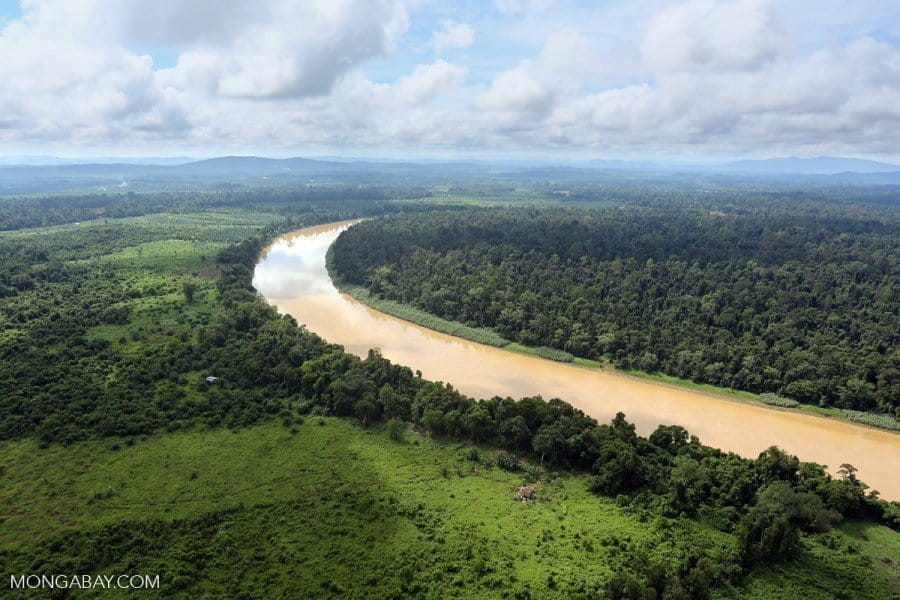
Malaysia
Sarawak gazetted 903,769 hectares (more than 2.2 million acres) of “total protected areas” and announced it was considering creating up to another 451,000 hectares of national parks, natural reserves, and wildlife sanctuaries. The state, located in Malaysian Borneo, has been hard hit by deforestation and forest degradation in recent decades, mostly the result of logging and conversion to industrial plantations.
Severe haze conditions in Peninsular Malaysia prompted the government to implement emergency fight-fighting and anti-haze measures.
A proposed road project sparked protests from environmentalists. The road would bisect dwindling elephant and orangutan habitat in Sabah, Malaysian Borneo.
Scientists condemned “misleading” reports from a major peat conference held in Malaysia. The reports claimed that draining peatlands was a sustainable activity and that people who said otherwise were “militant environmentalists” and “green NGOs”.
New trees were crowned the “world’s tallest” in Malaysia. In June, a group of researchers identified a 89.5 meter (293.6-foot) yellow meranti in Sabah as the tallest tree in the topics. However that record was short-lived. Once data was processed from an airplane-base mapping project undertaken by the Carnegie Airborne Observatory, nearly 50 taller trees were discovered across Sabah, including a 94.1-meter (nearly 309-foot) giant.
Sarawak Report, a muckraking web site focused on corruption in Malaysia, asserted that the owners of the Samling timber group have been channeling proceeds from their logging operations in Sarawak into U.S. investments including real estate holdings.
Myanmar
In Myanmar, logging was headline news after authorities implemented a nationwide ban. While the ban was welcomed by environmentalists, there were signs of discord within some circles, including the government. There were also indications that traders and illegal loggers continued to circumvent the ban, but a drop in demand from China may have temporarily eased some of the pressure on Myanmar’s forests. Nonetheless there were still dangers for journalists and others probing the sector. The Environmental Investigative Agency, an international NGO, said that illegal teak exports from Myanmar remain tainted.
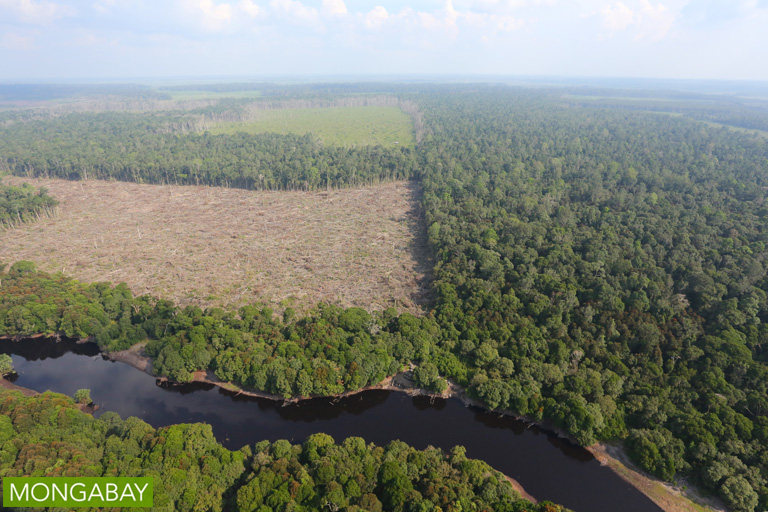
COMMODITIES
Zero Deforestation
Corporate zero deforestation commitments continued to increase, including the first by a major rubber buyer: Michelin Group, one of the world’s three largest tire companies. Activist groups had been slow to target the rubber business relative to other commodity sectors like soy, palm oil, timber, cattle and wood-fiber.
Several reports evaluated progress companies are making in implementing their commitments. Greenpeace, Forest Trends, and Union of Concerned Scientists were among the NGOs that weighed in on progress to date across various sectors. The Carbon Disclosure Project (CDP) and Climate Focus concluded that 2020 and 2030 targets set by the Consumer Goods Forum and signatories to the New York Declaration on Forests are unlikely to be met.
Conservation International issued a report asserting that coffee could become a significant driver of deforestation in coming years.
The government of Norway committed to a zero deforestation procurement policy.
Palm oil
The global price of palm oil increased sharply in 2016 but still remained well below 2006-2014 levels, curbing some producers’ enthusiasm for expanding production. Nonetheless, oil palm remained a major driver of deforestation in key hotspots including Borneo and Sumatra. Several countries moved forward with plans to develop or expand their domestic industries.
A study published in PLOS ONE identified where most deforestation for oil palm has occurred over the past 25 years and where expansion is likely to continue in the future. Other research published in Scientific Reports concluded that 4.5 to 4.8 million hectares of old-growth forests were cleared for oil palm plantations in Borneo between 1973 and 2015. That number was higher than previous estimates.
On the sustainability front, warring factions come to an agreement on a definition for “high carbon stock”. That compromise sets a common standard for zero deforestation policies increasingly being adopted by companies and governments.
At the the UN Climate Summit (COP22) in Marrakesh, Morocco, seven African countries pledged to protect their tropical forests from “unsustainable” oil palm development: Central African Republic, Côte d’Ivoire, Democratic Republic of Congo, Ghana, Liberia, the Republic of Congo, and Sierra Leone. At least two of those countries — Congo and Liberia — are facing criticism for oil palm development.
The Roundtable on Sustainable Palm Oil (RSPO) had a busy year. In March, the RSPO suspended Malaysian palm oil giant IOI for alleged misconduct in Indonesia’s West Kalimantan province. The suspension led several of IOI’s customers (including Cargill, Bunge, and Unilever, among others) to suspend or cancel purchases, prompting IOI to file a lawsuit against the RSPO. The suit was later dropped and the RSPO reinstated IOI over the protests of environmental groups. PanEco noisily resigned its RSPO membership, while consumer advocacy group Palm Oil Investigations (POI) dropped its support for the certification initiative.
Some major players in the sector — most notably the Malaysian and Indonesian governments — continued to resist calls for greater transparency. At the other end of the spectrum, World Resources Institute (WRI), Proforest, and Daemeter developed a risk assessment tool for palm oil buyers.
More palm oil developments can be found under individual country sections.
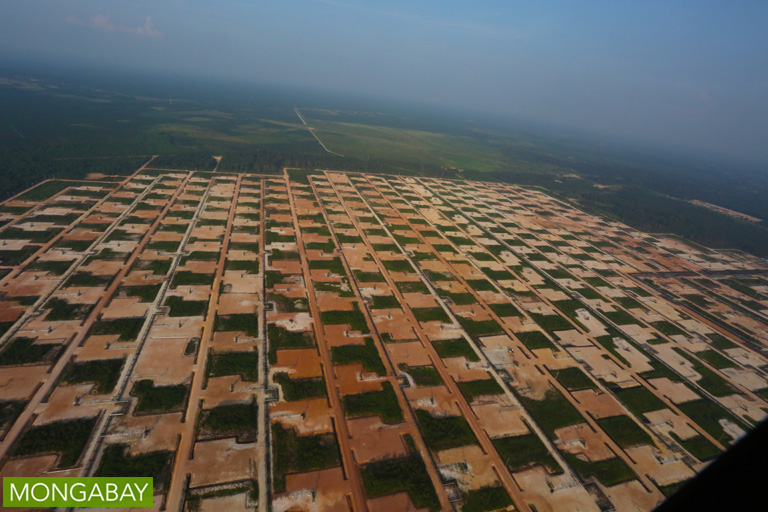
RIGHTS and GOVERNANCE
Indigenous rights
Indigenous and community rights in forests remained a major focus in 2016. Crossover mainstream attention came in April when the band Maroon 5 voiced support for community forestry projects in Guatemala and Alec Baldwin and UN Development Program administrator Helen Clark joined indigenous leaders at the UN headquarters to call for forest protections and land rights to combat climate change.
A number of reports argued that securing rights to community and traditionally-managed lands is one of the most effective ways to conserve forests and the ecosystem services they afford. For example, a World Resources Institute report argued that the economic benefits of securing land rights for Amazon communities would amount to billions of dollars. A raft of other reports highlighted case studies of communities stewarding forests in places ranging from Mesoamerica to Indonesia.
Survival International and WWF continued their standoff over the plight of the Baka ‘Pygmies’ in Cameroon, with Survival arguing that WWF has played a part in making the Baka “conservation refugees”. WWF strongly contests that characterization and said Survival is ignoring other factors in the region.
A report from Rainforest Foundation UK said that conservation efforts in Congo Basin countries aren’t working out very well for local people or wildlife. The report assessed 34 protected areas and concluded that 26 displaced local people and 21 had social conflicts. It noted that wildlife poaching remains rampant in the region.
Earth Innovation Institute and partners released a report arguing that well-designed jurisdictional approach to REDD+ and low-emission rural development can benefit indigenous peoples and traditional communities.
Endangered environmentalists
2016 was another dangerous year for environmentalists and journalists covering environmental issues. While dozens were murdered, some killings made international headlines for their brazenness, including Malaysian land rights activist Bill Kayong, Myanmar reporter Soe Moe Tun, Guatemalan community leader Walter Manfredo Méndez Barrios, and Brazilian government official Luiz Alberto Araújo.

Law enforcement
In June the U.S. Fish and Wildlife Service executed a search warrant executed at California-based Global Plywood and Lumber over alleged Lacey Act violations involving the smuggling of illegal timber from Peru.
An Interpol report said corruption in the global forestry sector is worth $29 billion a year. Bribery is the most common form of forestry corruption, according to the law enforcement agency.
A report coordinated by the International Union of Forest Research Organizations (IUFRO) in association with the Collaborative Partnership on Forests (CPF) put the value of forestry crime much higher: $152 billion per year. The report said more than 90 percent of the Democratic Republic of the Congo’s timber is illegal, followed by Cambodia at 90 percent, and Bolivia, Peru and Laos at 80 percent.
A European Commission review of the E.U. Timber Regulation law (EUTR) concluded the anti-illegal logging law is not being implemented effectively.

FOREST CONSERVATION and ECOLOGY
Ecology
Several major studies looked at the impact of hunting on tropical rainforests, including how hunting can stymie recovery and how the loss of big animals affects carbon sequestration. Other research documented how logging facilities the invasion of black rats into rainforest areas.
A team of researchers wrote a commentary in Proceedings of the National Academy of Sciences (PNAS) arguing that Amazon biodiversity could help fuel Fourth Industrial Revolution.
Scientists compiled a list of all known Amazon tree species, tallying 11,676 known tree species in 1,225 genera and 140 families. The said roughly 4,000 tree species remain undiscovered.
Yet another study showed that drought in the Amazon is inhibiting carbon storage. Like previous research, the paper warned that climate change could increase the intensity of droughts in the Amazon, worsening tree die-off and weakening Earth’s largest rainforest’s capacity to operate as a net carbon sink. Separately, NASA warned that the Amazon was facing severe drought conditions, heightening the risk of catastrophic wildfires.
More research documented the devastating impact plantation development is having on Indonesia’s peatlands, including increasing the risk of fire and releasing massive quantities of carbon dioxide.
A study argued that deforestation in India is reducing monsoon rainfall.
Research published in Current Biology attempted to better quantify the extinction and carbon debt of past deforestation. The authors concluded that even if rainforest deforestation had ceased in 2010, 140 vertebrate species would still go extinct and deforested areas would continue to release five to ten years’ worth of carbon emissions associated with clearing.
A Science Advances study published in December provided another example of how tropical deforestation and land use change drive the emergence of new diseases.
Forest restoration
Forest restoration got a lot of attention in 2016.
A series of papers published in Biotropica argued that the more than one billion hectares of degraded forest and woodlands across the tropics offer a huge opportunity for restoration and natural forest regeneration, enhancing biodiversity, sequestering carbon, and helping ecosystems become more resilient to climate change.
A report published by World Resources Institute said restoring 20 million hectares of forests in Latin America alone could sequester 5 billion metric tons of carbon dioxide while bolstering rural incomes.
Kenya embarked on a 20 million tree reforestation plan focusing on Kakamega Forest and its five “water towers”: Mount Kenya, the Aberdares, Mount Elgon, the Cherangani Hills, and the Mau Complex.
Technology
Technological advancements in monitoring forests and wildlife continued in 2016, including improvements in camera traps, timber sourcing and supply chain analysis, satellite and airplane-based sensors.
Global Forest Watch unveiled a number of new features on its forest monitoring platform, including high resolution, near real-time forest tracking in several countries, tools for monitoring commodity supply chains, and better satellite imagery layers. In June, the initiative got a $14 million boost from the Norwegian government.
Airbus, The Forest Trust and SarVision announced Starling, a service that uses Airbus’s satellites to peer through clouds and monitor changes in forest cover.
Scientists reported on the results of a two-year acoustic monitoring project in Cameroon. The data provided insight on hunting patterns, which could be useful for anti-poaching efforts.
A study published in Conservation Letters found that Brazil’s satellite monitoring system failed to detect 9,000 square kilometers of forest clearing in the Brazilian Amazon between 2008 and 2012.
Conservation and forest finance
A report from NGOs Friends of the Earth and As You Sow said U.S. mutual funds have a net investment of more than $5 billion in palm oil producers. The advocacy groups released the figures in an effort to pressure retirement fund giant TIAA to adopt stronger sustainability safeguards.
Rainforest Action Network, Profundo, and other NGOs launched a database that tracks banks’ investments in high deforestation risk sectors. The data show that between 2010-2015, banks in Asia, Europe, and the United States invested over $50 billion into “forest-risk” companies operating in Southeast Asia.
Forest Trends provided an update on the state of the forest carbon finance market, reporting that nearly a billion dollars was committed in 2015.
The Gordon and Betty Moore Foundation pledged another $100 million toward efforts to establish and support protected areas across the Andes-Amazon landscape. The foundation has already put $358 million into Amazon conservation areas and indigenous territories.
Research published in Global Environmental Change found that the poorest members of forest dependent communities in Madagascar were the least likely to directly benefit from carbon payment schemes.
Norway’s Government Pension Fund Global (GPFG), which manages $828 billion worth of funds, dropped eleven companies involved in deforestation from its portfolio.
A report from Forest Trends said that international financing for forest conservation in the Democratic Republic of Congo (DRC), Ghana, and Liberia has increased steadily since 2009.
A group of conservation NGOs published a report arguing that the aviation sector could partly meet its carbon emissions reductions goals by supporting forest conservation.
Forests and climate
A Nature study argued that current climate change pledges aren’t nearly enough to save the planet’s tropical ecosystems, especially cloud forests, rainforests, mangroves, and coral reefs.
Secondary forests in Latin America are sequestering an average of 122 tons of carbon per hectare over 20 years as the recover from initial clearing, demonstrating the climate benefits of allowing forests to naturally regenerate, reported a study published in Nature.
A study published in Science Advances argued that old-growth forests are critical in buffering biodiversity against the effects of climate change. The study found that old-growth forests moderate temperatures better than younger, secondary growth forests.
And the rest
The Bornean orangutan was uplisted to “critically endangered” on the IUCN Red List due to hunting, habitat destruction, habitat degradation and fragmentation.
The Norway and U.S. pledged to work more closely on forest protection efforts.
An analysis by World Resources Institute found the world’s watersheds lost six percent of their forests in just 14 years.
A Science study using crowd-sourced data found that roads have fragmented Earth’s land surface into 600,000 pieces, with only seven percent of roadless areas larger than 100 square kilometers. The authors cautioned that the results are conservative — the data set likely misses a significant proportion of the world’s roads.
Keep track of rainforest news as it happens
See our rainforests news feed and rainforests XML feed. Or subscribe to our rainforests email alert.
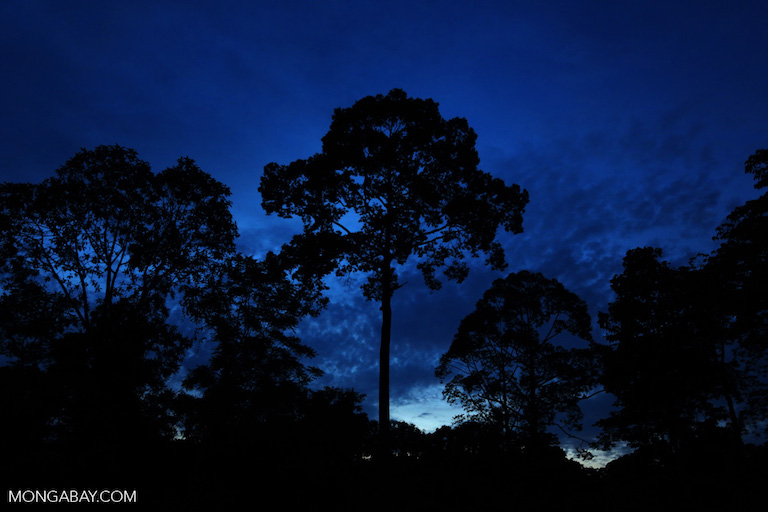
Reviews from past years: 2015 | 2014 | 2013 | 2012 | 2011 | 2009
Did I miss something? Feel free to comment publicly below or use the following form to contact me.


